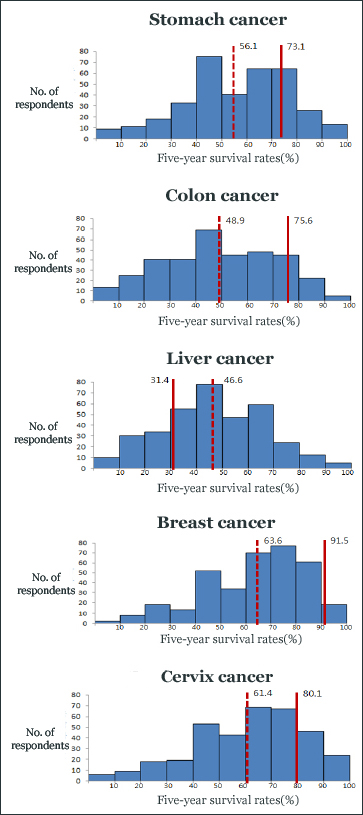The popular awareness about cancer survival rates is far lower than real levels shown by epidemiological data.
A research paper titled “Discrepancies between public perceptions and epidemiological facts regarding cancer survival rate in Korea,” recently published in the Korea Contents Association Journal, released the public perceptions about five-year survival rates of five major cancers -- stomach, colon, liver, breast and cervix cancer.
The paper was co-written by researcher Kim Jae-woo김재우 of Gachon University Gil Medical Center가천대길병원, Professor Kang Jung-kyu강정규 of Cheongju University청주대, and Professor Kim Sung-ho김성호 of College of Health Science of Yonsei University연세대.

They conducted an online survey of 354 people and found considerable discrepancies between public perceptions and epidemiological data about the five-year survival rates.
The results showed the public awareness of five-year survival rates for stomach, colon, breast, and cervix cancer was 17 percent, 26.7 percent, 27.9 percent and 18.7 percent lower, respectively than those confirmed by epidemiological data.
In the case of liver cancer, the public’s perceived five-year survival rate was 15.2 percent higher than data, which the researchers attributed to the liver cancer’s actual five-year survival rate is much lower than those of other types of cancer.
Factors affecting people’s perceptions of survival rates include whether there are cancer diagnoses or not (in the cases of stomach, colon and liver cancer), patients’ ages (in stomach and cervix cancer) and whether patients take regular physical exercises (in cervix cancer).
"Researches into factors related to the popular perceptions of survival rates have been very inadequate, both here and abroad,” the authors said. “We can assume older people and those who have taken cancer examinations are more interested in health issues and feel more fully realize its value, making preventive efforts more frequently than those who have not and have a higher perception of the cancer survival rates."
Researchers emphasized the need to rectify their underestimating trend of survival rate, which they said resulted in the low level of participation in cancer checkups.
"It is crucial to correctly understand popular perception to make a decision concerning the prevention and treatment of cancer,” the paper said. “Medical staffs have to explain real risks or survival rate-related information to patients when they visit hospitals in the course of regular medical checkup or consultation for cancer treatments."
"And they have to try to narrow down the discrepancies between incorrect popular understanding and epidemiological data because such attempts will help them make a decision on preventing and treating cancer,” it went on to say. “Also, such improved perceptions will be of much help for reducing unnecessary fear and cancer-related stigma.”

